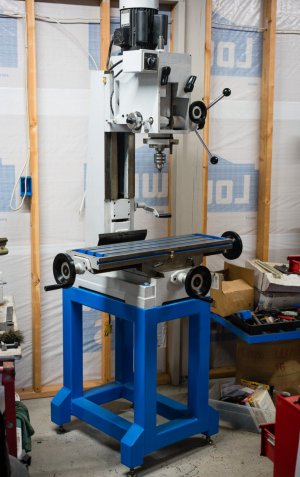- Joined
- Sep 10, 2020
- Messages
- 34
The PM-935 weighs about 1500 pounds, right? How did you raise it 11"? That's raising the center of gravity 11". Being a knee mill, maybe raising it that much may not be such a big deal because the base is so heavy.
But that's what I am dealing with on a PM 932 class bench mill. Having a Bolton ZX-45, I'm a Precision Matthews wanta be.
Hello everyone, post #1. Besides not having a base for my mill, I am picky about working height being 5' 11" and shrinking a bit by the year. My only solution is to make a base. My concerns are raising a fully loaded 900 pound mill to give a hopefully 40"ish table height. I've thought a lot about using concrete as a cost effective base, but not able to move the mill is an issue and the situation of earthquakes here in California. I really like the concrete pad solution up thread and I suppose it could be surfaced to move laterally if one desired, and when bolted to an existing base would lower the center of gravity.
Common wisdom dictates a base that slides laterally during an earthquake, as in the high rise building construction that has a shock system that moves horizontally. A high center of gravity system such as a heavy tall milling machine is not something you want to bolt to a concrete slap, at least here in California.
So, my in progress solution is a mill base made with 3" square, 1/8" wall tubing that will be 29+" high. The mill base to mill table height is almost 10", giving a height from floor of about 39". A 5" vise would add 3" to that.
Back on the concrete subject, it and epoxy resin is currently being used for structural vibrational stability of CNC builds. My idea is to fill the 3" square tubing with concrete to add mass and maybe add epoxy resin to the mill base and lower Z axis part.
Anyway, I have to finish the base in order to build the mill which is torn down. Maybe I can post another or 2 to earn the right to post photos of my progress. (In the right section)
But that's what I am dealing with on a PM 932 class bench mill. Having a Bolton ZX-45, I'm a Precision Matthews wanta be.
Hello everyone, post #1. Besides not having a base for my mill, I am picky about working height being 5' 11" and shrinking a bit by the year. My only solution is to make a base. My concerns are raising a fully loaded 900 pound mill to give a hopefully 40"ish table height. I've thought a lot about using concrete as a cost effective base, but not able to move the mill is an issue and the situation of earthquakes here in California. I really like the concrete pad solution up thread and I suppose it could be surfaced to move laterally if one desired, and when bolted to an existing base would lower the center of gravity.
Common wisdom dictates a base that slides laterally during an earthquake, as in the high rise building construction that has a shock system that moves horizontally. A high center of gravity system such as a heavy tall milling machine is not something you want to bolt to a concrete slap, at least here in California.
So, my in progress solution is a mill base made with 3" square, 1/8" wall tubing that will be 29+" high. The mill base to mill table height is almost 10", giving a height from floor of about 39". A 5" vise would add 3" to that.
Back on the concrete subject, it and epoxy resin is currently being used for structural vibrational stability of CNC builds. My idea is to fill the 3" square tubing with concrete to add mass and maybe add epoxy resin to the mill base and lower Z axis part.
Anyway, I have to finish the base in order to build the mill which is torn down. Maybe I can post another or 2 to earn the right to post photos of my progress. (In the right section)


